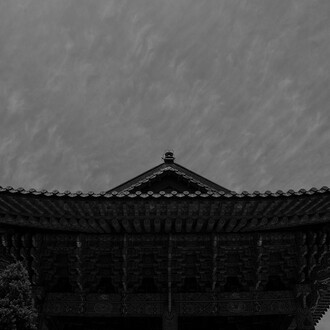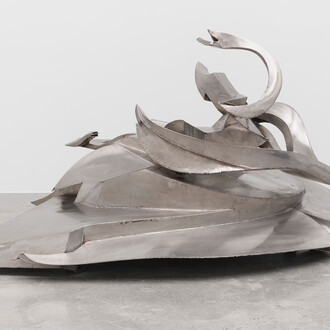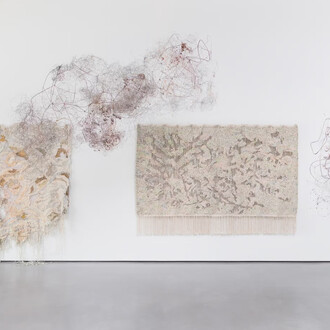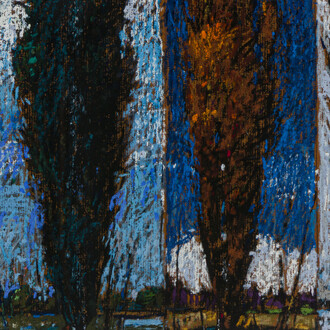Peter Freeman, Inc., New York, is pleased to present Alex Hay: Circumstance / Art. This is the gallery’s fifth exhibition with the artist, and the first anywhere to focus exclusively on the conceptual and performative aspects of Hay’s practice. On view will be works from the 1960s up to the present, made in New York, California, and Arizona.
Circumstance has always been an impetus for Hay’s work. By responding to and recording his whereabouts or activities, making use of a tool or material at hand, or employing something even as unpredictable as the weather, Hay’s work reflects his state of perpetual observation and acute presence.
The newest work on view—begun in 2003—is a sculpture formed from the masking tape stencils integral to Hay’s painting process. Upon completing each layer of a painting, Hay pulls away and accumulates the corresponding tape layer creating the form of a ball and adding to it as the painting is completed.
There are eleven balls, one for every stenciled painting he has made over the last twelve years. The paintings depict wood scraps and linoleum (themselves the byproduct of Hay’s former construction projects which he retained to put to a later use). Each ball, unique in scale and coloration as it represents the process that went into its corresponding painting, rests on a handmade plaster base that preserves its contoured form, and sits lined up together on one shelf to create a catalogue of sorts of Hay’s paintings over the past decade.
Earlier works, some of which Hay exhibited at New York’s Kornblee Gallery in the 1960s, and later in a solo show at the New York Cultural Center in 1971, include Collection Bags, Ground Drawings, and Sun Prints, all made in California; and Street Prints and Sidewalk Prints, as well as several painted cast resin floor planks, all made in or just outside of Hay’s former studio on Crosby Street in Soho. The prints and drawings were a reaction to a special type of paper he obtained from Gemini (which he used for the four bodies of works on paper on view here), and, in the case of the Ground Drawings, the allure of a tool (a leveling protractor), and particularities of the ground in the canal area of Venice. Some of the ideas in these early pieces grew out of Hay’s early performance work, in which ideas about repetitive action and observation can lead to an accumulation of knowledge not otherwise possible.
Alex Hay was born in 1930 in Valrico, Florida. He lives and works in Bisbee, Arizona. As Hay’s paintings were gaining recognition in the 1960s, exhibited at New York’s Leo Castelli Gallery and Kornblee Gallery and included in the first survey of Pop Art at London’s Hayward Gallery in 1968, he was also separately participating in collaborative performances with such frequent cohorts as Robert Rauschenberg, John Cage, and Merce Cunningham. These were primarily at the Judson Dance Theatre, the preeminent American experimental performance space at the time. In 1966, a performance by Hay was one of the famous 9 Evenings; other evenings were dedicated to performances by Rauschenberg, Cage, Yvonne Rainer, and five other artists. In the early 70s he moved to Arizona and ceased exhibiting until a 2002 solo exhibition of his work from the 60s at Peter Freeman; that same year he began to paint again.
Recent group exhibitions have included the Whitney Biennial at the Whitney Museum of American Art, New York (2004), The Painted World at P.S. 1 Contemporary Art Center, New York (2005), Danser sa vie at the Centre Pompidou, Paris (2011), and Lifelike at the Walker Art Center, Minneapolis (2012, then travelled through 2014). His work is in a number of museum collections, including: The Whitney Museum of American Art, New York; Museum of Modern Art, New York; San Francisco Museum of Modern Art; The Art Institute of Chicago; Moderna Museet, Stockholm; and Museu Serralves, Porto.
A reception for the artist will be held Thursday 7 January from 6 to 8 pm.



















